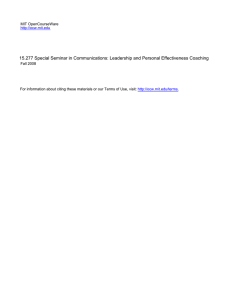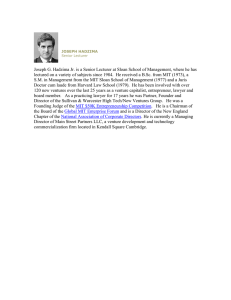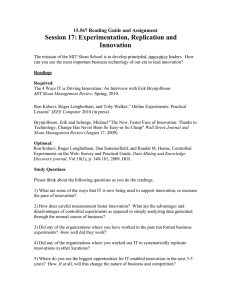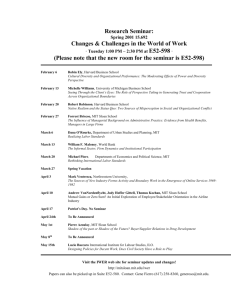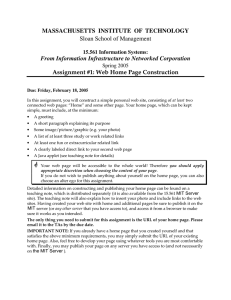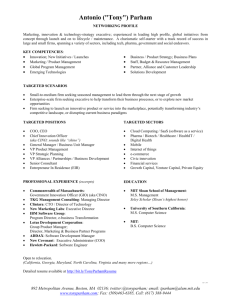15.992 S-Lab: Laboratory for Sustainable Business
advertisement
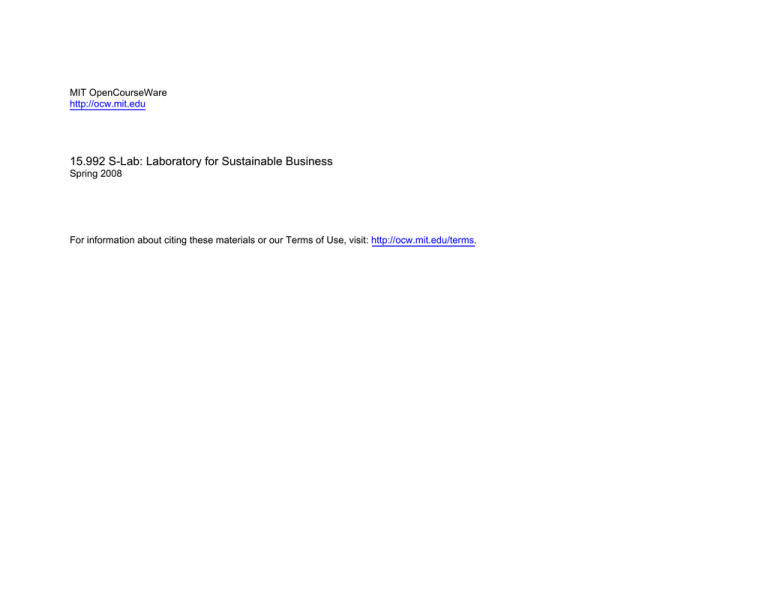
MIT OpenCourseWare http://ocw.mit.edu 15.992 S-Lab: Laboratory for Sustainable Business Spring 2008 For information about citing these materials or our Terms of Use, visit: http://ocw.mit.edu/terms. Sustainable Infrastructure and International Markets Prof. Sarah Slaughter S-Lab (15.992) April 15, 2008 © 2005 MIT Sloan School of Management Infrastructure Systems Core Enabling Systems for Civil Society and Commerce • Water • Wastewater • Stormwater • Solid Waste • Energy • Telecommunications • Transportation (RED: Usually publicly owned and operated) © 2007 MIT Sloan School of Management Basic Statistics • Construction expenditures ~$5 trillion per year worldwide • Infrastructure construction expenditures ~ $1.6 trillion/yr • Expected Rate of Infrastructure Expenditure Growth – Czech Republic – 16% in 2007 – India – 14%/yr (projected) – China –9%/yr (projected) – Brazil – 6%/yr (projected) (Source: Business Monitor International, 2008) © 2007 MIT Sloan School of Management UN Millennium Development Goals • By 2015: – Goal 1: Eradicate Extreme Hunger and Poverty – Goal 2: Achieve Universal Primary Education – Goal 3: Promote Gender Equality and Empower Women – Goal 4: Reduce Child Mortality – Goal 5: Improve Maternal Health – Goal 6: Combat HIV/AIDS, Malaria and other diseases – Goal 7: Ensure Environmental Sustainability – Goal 8: Develop a Global Partnership for Development (Resources: www. Un.org/millenniumgoals/, www.mdgmonitor.org) © 2007 MIT Sloan School of Management Goal 7, World Wide Access to Water and Sanitary Services Source: UN 2006, Proportion of Population Over 1 billion people lack clean drinking water (Source: UN, 2006) UN Millennium Development Goal 7:Halve Proportion without improved drinking water, Halve proportion without sanitation © 2007 MIT Sloan School of Management Global Drought Monitor (Nov 07) Image removed due to copyright restrictions. World map with drought locations by Dr. Benjamin Lloyd-Hughes and Professor Mark Saunders. Updated map available at http://drought.mssl.ucl.ac.uk/ Population under current exceptional drought: 58,140,000 © 2007 MIT Sloan School of Management Drought Areas • Australia (Science News, 10/27/07, p. 266-268) • United States – Southwest (NYT Magazine, 10/21/07, p. 68-77, 104, 154-155) – Southeast (WSJ, 10/26/07, p. 1) – Northwest (Idaho, Montana) • South America (Venezuela, Peru, Southern Chile) • Africa (Algeria, Southern Africa, Somalia) • Mediterranean (Turkey, Russia) © 2007 MIT Sloan School of Management IPCC Projected Worldwide Temperature Trends Image removed due to copyright restrictions. Source: "Projected Temperature Changes, 2000 to 2100 Scenario." By UNEP/GRID-Arendal. © 2007 MIT Sloan School of Management Water Shortage Causes • Weather Changes – El Nino, La Nina – Global Climate Warming • Land Use Changes – Forest clearing – Landscaping (nonnative) • Human Water Use – Increased irrigated agriculture – Increased population – Increased industrial use – Increased household use © 2007 MIT Sloan School of Management Water Shortage Impacts • Economic – Agriculture – Industry – Tourism and recreation – Energy – Financial – Transportation • Environment – Animal/Plant – Wetland – Water quality • Social – Stress and health – Nutrition – Recreation – Public Safety – Cultural Values – Aesthetic Values http://www.drought.unl.edu/mitigate/mitigate.htm, “How to Avoid Drought”, 1998 © 2007 MIT Sloan School of Management IPCC Projected Rising Sea Levels Image removed due to copyright restrictions. Source: "Coastlines Under Threat." By UNEP/GRID-Arendal. © 2007 MIT Sloan School of Management US Stream Flow Real-time vs historical streamflow for the day of the year http://water.usgs.gov/waterwatch/ © 2007 MIT Sloan School of Management Water and Wastewater Power 47% Source Agriculture 34% Commercial Residential 11% Other 3% Treatment Retention Industry 5% 408 billion gallons/day 345 billion gallons/day freshwater 62 billion gallons/day saline Source: USGS, 2000 © 2007 MIT Sloan School of Management US Municipal Solid Waste, 2005 Source: EPA, 2005 Weight Solid Generated Percent Waste Proportion Products (tons) Recovered (tons) of Total Containers and Packaging 76.7 40% 46.2 28% Other Wastes 65.0 32% 44.5 27% Nondurable Goods 63.7 32% 43.3 26% Durable Goods 40.3 19% 32.8 20% Total 245.7 32% 166.8 In the US, each person generates 720 kg per year. In Mexico, each person generates less than 300 kg/yr (Source: US Census, 1997) © 2007 MIT Sloan School of Management US Energy Consumption by I/BE: 97 Quad Btus in 1999 In Asia and Pacific Region, over 800 million people are without access to electricity or clean energy (UN, 2005) Source: US Census, 1999 © 2007 MIT Sloan School of Management US Residential Energy Use: 9.9 Quad Btus in 1999 Source: US DOE, 2001 © 2007 MIT Sloan School of Management US Transportation Modes: CO2 Emissions and Energy Use Boston to London RT is 6,507miles and generates 2,538 lbs of CO2 Boston to Tokyo RT is 13,414 and generates 5,232 lbs of CO2 © 2007 MIT Sloan School of Management Telecommunications Infrastructure Source: UN Millennium Development Goals Report, 2006 © 2007 MIT Sloan School of Management Boston Area Infrastructure Infrastructure System Cambridge Boston Lenox, MA Water Sewage Solid Waste Last Major Transport Green Buildings © 2007 MIT Sloan School of Management Boston Area Infrastructure Infrastructure System Cambridge Boston Lenox, MA Water Fresh Pond Reservoir MWRA, Quabbin Reservoir Wells, Local reservoir Sewage MWRA, Deer Island MWRA, Deer Island Septic tanks, Local treatment Solid Waste Trucked to western Mass Trucked to western Burn barrel, Local Mass. dump Last Major Transport Red Line to Alewife Central Artery, Third Harbor Tun Highway improvements Green Buildings All city bldgs and major renov All city, major construct, renov MTC Cities for Climate Protect Plan © 2007 MIT Sloan School of Management Opportunities “30% of California urban water use can be reduced using existing technologies, to avoid or delay new reservoirs and other water sources.” (Pacific Institute, 2003) • Major Actions – Eliminate Waste – Increase Efficiency – Reconsider Resource Use – Re-Use Resource – Develop New Sources © 2007 MIT Sloan School of Management Example Community: Fort Lewis, US Army, WA • Fort Lewis covers 87,000 acres in Washington State • Yakima Training Center covers 324,000 acres. • 25,000 soldiers and civilian workers, with 120,000(+) retirees and more than 29,000 family members living both on and off post. • Adjacent to McChord Air Force Base © 2007 MIT Sloan School of Management Fort Lewis, WA Drivers for Sustainability: • 2000 – New Requirements for Environmental Management – The Senior Environmental Leadership Conference (SELC), March 2000, mandated that installations establish an integrated strategy – Executive Order 13148, Leadership in Environmental Management, 22 Apr 2000. • 2002 Base Workshop to develop Installation Sustainability Program – Environmental groups and regulation agencies – Community – Army HQ and Installation © 2007 MIT Sloan School of Management Fort Lewis, WA • Installation Sustainability Program Goals (2002) – Air Quality – Reduce Emissions by 85% by 2025 – Energy/Infrastructure – On-site energy generation and Platinum LEED for all buildings by 2025 – Material Mgt – Zero net waste by 2025 – Sustainable Training Lands – Regenerate all lands and species by 2025 – Water Resources – Zero wastewater and 75% reduction in water use by 2025 © 2007 MIT Sloan School of Management Fort Lewis, WA • 2005-2006 Progress (Selected examples) – Air Quality • 40% on-installation vehicles are alternate or dual fuel • 190 Rideshare participants • Switched boiler fuel to reduce stationary emissions – Energy/Infrastructure • Buildings upgrades with 5-30% energy use reductions • Targeting overall reduced energy use of 2% by 2007 • 10% Green power purchased, target +5% by 2007 • Rainwater harvesting cistern completed in barracks project © 2007 MIT Sloan School of Management Fort Lewis, WA • 2005-2006 Progress (Selected examples – cont’d) – Products and Material Management • Biosolid composting facility completed • 9,100 tons recycled asphalt, concrete (savings $340k/y) • 97 illegal dump sites cleaned (pot. savings $350k/y) • Cradle-to-cradle Hazardous Materials delivery service – Sustainable Training Lands • Cooperation with The Nature Conservancy on habitat restoration and species reintroduction for 127 acre prairie preserve • Cleared 1581 acres of invasive nonnative plants © 2007 MIT Sloan School of Management Fort Lewis, WA • 2005-2006 Progress (Selected examples – cont’d) – Water Resources • On-site remediation of contaminated groundwater site (ahead of schedule) • Grey water reclamation in all barracks • Extensive replacement of water mains and connectors to reduce leakage © 2007 MIT Sloan School of Management Example New Community: Noisette, SC • Master Plan for North Charleston – 3,000 acres with 400 acres Decommissioned Navy Yard (2004) – Sustainable land use patterns – Natural systems restoration – Ecological storm water management – Highly-connected transportation design – Network of recreational elements – Schools as centers of community – Integration of art throughout community – Training/rebuilding local community (Source: Harry Gordon, CEO, Burt Hill, 2007, http://www.noisettesc.com) © 2007 MIT Sloan School of Management Noisette, SC • Water/Wastewater (Stormwater) – Direct through street bioswales into central pond • Reconstruct Natural Waterways – Noisette Creek with 200 acre preserve • Renovation of existing buildings and construction of new buildings to sustainability guidelines (LEED) • New businesses focused on sustainability © 2007 MIT Sloan School of Management Noisette, SC • Current Progress (Selected examples) – 101 EarthCraft-certified homes under contract, with 400 preserved trees and innovative features like recycled building materials. – Green Buildings: construction and renovation of older buildings, with green roofs and geothermal climate control. – 1 LEED Platinum – Prisoner Re-Entry Training Program – green building techniques © 2007 MIT Sloan School of Management Noisette, SC • New companies located: – Southeast Biodiesel, which produces alternative fuels for marine vessels and automotive markets. – Coast Brewing Company, a microbrewery producing beers made with organic grains, utilizing recycled equipment and eco-friendly manufacturing processes. – Lowcountry Local First which supports local, sustainable businesses. – Fisher Recycling – The Verdi Company, green homebuilder Source: http://www.noisettesc.com/index.html © 2007 MIT Sloan School of Management New Company Example: Water Health • New technology – filtration with proprietary UV treatment • New Business Model: – Provide community financing – Design and build turnkey modular units – Train local community to operate, maintain – Scalable as community develops – Community education and containers for health and hygiene – Franchised “water stores” © 2007 MIT Sloan School of Management Water Health Progress to date: • India – 50 WaterHealth Centres installed in the state of Andhra Pradesh • Philippines – Over 50 urban water store franchises across metropolitan Manila • Ghana • Sri Lanka (after tsunami) – Installed capacity to provide safe drinking water for least 21,500 survivors © 2007 MIT Sloan School of Management Example Next Generation Technologies: Microbial Fuel Cell • Waste water (including sewage) as fuel, creates electricity and water and compost • Pilot plant: Brewery in Australia, brewery wastewater is used as feed. – Carbon fibre anodes and cathodes are used, based on a brush design. Source: http://www.microbialfuelcell.org/, Jeremy Patten, The University of Queensland © 2007 MIT Sloan School of Management New Company Example: Ecochlor • New international regulations to reduce invasive aquatic organisms • Treatment of Ballast Water in Ships – Chlorine Dioxide kills organisms (including in saltwater) – Nontoxic after rapid degradation © 2007 MIT Sloan School of Management New Company Example: Sterecycle • • New technology – Steam Autoclave New Business Model: – Finances, builds, owns, and operates recycling facility – Can recycle and recover ~80% of domestic waste – Can be used before traditional systems © 2007 MIT Sloan School of Management
